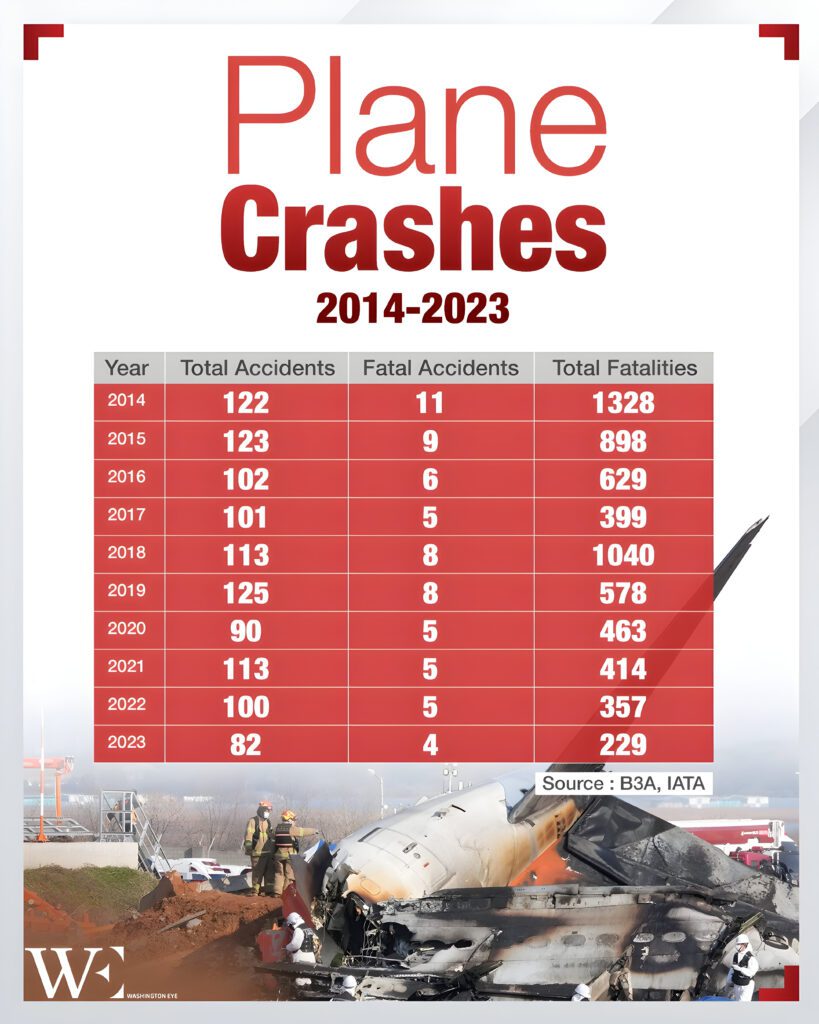In recent months, the world has witnessed a troubling series of plane crashes, reigniting concerns over aviation safety, mechanical failures, pilot errors, and extreme weather conditions.
The latest crash near Washington, D.C., further intensified fears, prompting calls for enhanced safety measures and rigorous investigations. American Airlines regional passenger jet and a U.S. Army Black Hawk helicopter crashed into the Potomac River near Ronald Reagan Washington National Airport.
The passenger jet carried 60 passengers and four crew members, while the helicopter had three soldiers on board. Authorities fear there are no survivors; as of now, 27 bodies have been recovered from the plane and one from the helicopter. Rescue operations are ongoing, with over 300 first responders involved. Conditions are challenging due to cold and windy weather.
On 25 December 2024, Azerbaijan Airlines Flight 8243 took off from Baku bound for Grozny in Chechnya, with 67 passengers and crew onboard. As the plane neared Grozny in Russian airspace, it appeared to have come under fire from the ground and changed course east, crashing near Aktau in western Kazakhstan. Only 29 people survived. Preliminary reports suggest a possible fuel system failure, but authorities are continuing their investigation.
On December 29, 2024, Jeju Air Flight 2216, a Boeing 737-800, crashed during its approach to Muan International Airport in South Korea, resulting in 179 fatalities. Preliminary investigations revealed that bird remains, specifically from Baikal teals, were found in both engines, indicating a bird strike. The aircraft crashed after landing late on the runway at high speed with no landing gear deployed and no use of wing flaps. The cause of the crash remains unidentified, as the black box data cut off four minutes before the explosion, possibly due to an electrical failure.
Key Reasons Behind Recent Air Disasters
Several incidents, including today’s Washington, D.C., crash, have been linked to technical malfunctions. The increasing reliance on automated systems has raised concerns about potential software glitches. Investigations into previous crashes highlight the role of human error, often exacerbated by stress, fatigue, or lack of proper training.
Climate change has also led to unpredictable weather patterns, with turbulence and storms increasing the risk of accidents. With the rapid increase in global air travel, congestion in the skies has led to miscommunications, miscalculations, and near-collisions. Some crashes have been attributed to airlines operating aging fleets, resulting in technical failures and compromised safety.
Ongoing Investigations and Safety Measures
Following each crash, aviation authorities have launched thorough investigations to identify causes and prevent future accidents. The FAA, NTSB, and other global regulatory bodies are now under increasing pressure to impose stricter regulations.
The International Civil Aviation Organization (ICAO) has urged airlines to prioritize pilot training, routine aircraft maintenance, and real-time monitoring systems that can detect early signs of mechanical failures. Some airlines are also considering new artificial intelligence (AI) powered safety mechanisms that can assist pilots in identifying and responding to emergencies.
In the wake of these tragic incidents, several governments have pledged to strengthen aviation safety laws. The European Union, for example, has proposed mandating more frequent aircraft inspections, while the United States is considering updating outdated air traffic control infrastructure to enhance efficiency and reduce risks.
The Human Cost of Aviation Tragedies
Behind every crash are the stories of lives lost and families shattered. In today’s Washington, D.C., crash, a family of four was reportedly among the victims. The Japan crash claimed the lives of young students, while the Nepal tragedy left an entire village grieving. Survivors and families of victims have demanded greater transparency in investigations and stricter enforcement of safety measures.
Many are advocating for reforms in the aviation industry to prevent future disasters and hold airlines accountable for safety lapses.
Despite advancements in technology and regulatory oversight, aviation safety remains a global challenge. While flying is statistically one of the safest modes of transport, recent crashes serve as a grim reminder that improvements are still needed.
Experts argue that the aviation industry must focus on a multi-pronged approach investing in cutting-edge technology, enforcing rigorous pilot training, and enhancing real-time monitoring systems to ensure safer skies. As investigations into these recent crashes continue, the world watches closely, hoping for answers and solutions to prevent further tragedies.
As authorities and aviation experts work toward identifying solutions, one thing is clear: the safety of passengers and crew must remain the top priority in global air travel.















